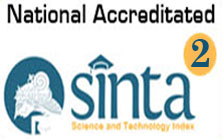Evaluation of Hematotoxicity in Female Wistar Rats Following Sub-Acute Inhalation Exposure to Polyethylene Microplastic
DOI:
https://doi.org/10.31965/infokes.Vol22.Iss2.1585Keywords:
Microplastic, Polyethylene, Inhalation, Blood, ToxicityAbstract
Polyethylene (PE) becomes a source of microplastics that can be widely distributed through the digestive and respiratory systems. However, its effects on blood cells are still being investigated. This study aims to analyze the impact of Polyethylene Microplastic (PE-MPs) exposure on the blood of female rats, including erythrocytes, leukocytes, and platelets. This study used female Wistar rats, which were divided into control and PE-MP groups. PE-MP was administered via whole-body inhalation at a concentration of 15 mg/m³ for 4 hours daily for 28 days. The absorption of plastic particles detected in the human bloodstream is likely to occur through mucosal contact (either through ingestion or inhalation). After the exposure period, the rats were euthanized to collect blood samples through the heart. A complete blood count was performed using an automatic hematology analyzer, and blood morphology was analyzed using thin blood smears. This study used the Mann-Whitney test. PE-MP exposure increased erythrocyte and platelet counts without a corresponding rise in leukocytes. Erythrocytes showed abnormal morphology (12.73% with ovalocytes and tear-shaped cells). Erythrocyte indices (MCV, MCH, MCHC) showed no significant differences. Platelet count rose by 1.7% (p-value= 0.017). Leukocyte and neutrophil counts were lower (0.84 and 0.94 times lower, respectively), while lymphocytes and monocytes were higher (1.03 and 1.61 times higher, respectively) in the PE-MP group compared to controls. The neutrophil-to-lymphocyte ratio did not differ significantly. PE-MP exposure in rats disrupts blood parameters, altering erythrocyte morphology and increasing platelet counts. Potential causes include oxidative stress, immune responses, and compensatory mechanisms. Study limitations include a small sample size and exclusive focus on inhalation exposure. Integrating multiple exposure routes (inhalation, ingestion, dermal) could offer a broader view of microplastic impacts. Future research with larger samples, diverse doses and durations, and exploration of additional markers or organ-specific effects is crucial for understanding PE-MP toxicity in real-world scenarios.
Downloads
References
Abdel-Zaher, S., Mohamed, M. S., & Sayed, A. E. D. H. (2023). Hemotoxic effects of polyethylene microplastics on mice. Frontiers in Physiology, 14, 1072797. https://doi.org/10.3389/fphys.2023.1072797
Arias, C. F., Valente-Leal, N., Bertocchini, F., Marques, S., Acosta, F. J., & Fernandez-Arias, C. (2024). A new role for erythropoietin in the homeostasis of red blood cells. Communications Biology, 7(1), 58. https://doi.org/10.1038/s42003-023-05758-2
Arifin, W.N., Zahiruddin, W.M. (2017). Sample size calculation in animal studies using resource equation approach. Malays. J. Med. Sci. 24, 101–105. https://doi.org/10.21315/mjms2017.24.5.11
Buonacera, A., Stancanelli, B., Colaci, M., & Malatino, L. (2022). Neutrophil to Lymphocyte Ratio: An Emerging Marker of the Relationships between the Immune System and Diseases. International Journal of Molecular Sciences, 23(7), 3636. https://doi.org/10.3390/ijms23073636
Cary, C. M., Seymore, T. N., Singh, D., Vayas, K. N., Goedken, M. J., Adams, S., Polunas, M., Sunil, V. R., Laskin, D. L., Demokritou, P., & Stapleton, P. A. (2023). Single inhalation exposure to polyamide micro and nanoplastic particles impairs vascular dilation without generating pulmonary inflammation in virgin female Sprague Dawley rats. Particle and fibre toxicology, 20(1), 16. https://doi.org/10.1186/s12989-023-00525-x
Chwalba, A., Maksym, B., Dobrakowski, M., Kasperczyk, S., Pawlas, N., Birkner, E., & Kasperczyk, A. (2018). The effect of occupational chronic lead exposure on the complete blood count and the levels of selected hematopoietic cytokines. Toxicology and applied pharmacology, 355, 174–179. https://doi.org/10.1016/j.taap.2018.05.034
Enyoh, C. E., Verla, A. W., Verla, E. N., Ibe, F. C., & Amaobi, C. E. (2019). Airborne microplastics: A review study on method for analysis, occurrence, movement and risks. Environmental Monitoring and Assessment, 191(11), 668. https://doi.org/10.1007/s10661-019-7842-0
Espinosa, C., Beltrán, J. M. G., Esteban, M. A., & Cuesta, A. (2018). In vitro effects of virgin microplastics on fish head-kidney leucocyte activities. Environmental Pollution, 235, 30-38. https://doi.org/10.1016/j.envpol.2017.12.054
Farag, A. A., Youssef, H. S., Sliem, R. E., El Gazzar, W. B., Nabil, N., Mokhtar, M. M., Marei, Y. M., Ismail, N. S., Radwaan, S. E., Badr, A. M., & Sayed, A. E.-D. H. (2023). Hematological consequences of polyethylene microplastics toxicity in male rats: Oxidative stress, genetic, and epigenetic links. Toxicology, 492, 153545. https://doi.org/10.1016/j.tox.2023.153545
Franco, R., Navarro, G., & Martínez-Pinilla, E. (2019). Antioxidant defense mechanisms in erythrocytes and in the central nervous system. Antioxidants, 8(2), 46. https://doi.org/10.3390/antiox8020046
Hamed, M., Osman, A. G. M., Badrey, A. E. A., Soliman, H. A. M., & Sayed, A. E.-D. H. (2021). Microplastics-Induced Eryptosis and Poikilocytosis in Early-Juvenile Nile Tilapia (Oreochromis niloticus). Frontiers in Physiology, 12, 742922. https://doi.org/10.3389/fphys.2021.742922
Iheanacho, S. C., & Odo, G. E. (2020). Neurotoxicity, oxidative stress biomarkers and haematological responses in African catfish (Clarias gariepinus) exposed to polyvinyl chloride microparticles. Comparative Biochemistry and Physiology Part C: Toxicology & Pharmacology, 232, 108741. https://doi.org/10.1016/j.cbpc.2020.108741
Kumar, N., Ukey, P. D., Francis, V., Singh, R. P., & Sahu, S. (2022). Plastic pellets. In Polymers for 3D Printing (pp. 307-323). William Andrew Publishing. https://doi.org/10.1016/B978-0-12-818311-3.00019-7
Lee, C.-J., Smith, D. W., Gardiner, B. S., & Evans, R. G. (2019). Stimulation of erythropoietin release by hypoxia and hypoxemia: Similar but different. Kidney International, 95(1), 23–25. https://doi.org/10.1016/j.kint.2018.09.025
Leslie, H.A., van Velzen, M.J.M., Brandsma, S.H., Vethaak, A.D., Garcia-Vallejo, J.J., Lamoree, M.H. (2022). Discovery and quantification of plastic particle pollution in human blood. Environ. Int. 163, 107199. https://doi.org/10.1016/j.envint.2022.107199
Lett, Z., Hall, A., Skidmore, S., & Alves, N. J. (2021). Environmental microplastic and nanoplastic: Exposure routes and effects on coagulation and the cardiovascular system. Environmental Pollution, 291, 118190. https://doi.org/10.1016/j.envpol.2021.118190
Li, Y., Tao, L., Wang, Q., Wang, F., Li, G., & Song, M. (2023). Potential Health Impact of Microplastics: A Review of Environmental Distribution, Human Exposure, and Toxic Effects. Environment & Health, 1(4), 249–257. https://doi.org/10.1021/envhealth.3c00052
Mentes, D., Nagy, G., Szabó, T. J., Hornyák-Mester, E., Fiser, B., Viskolcz, B., & Póliska, C. (2023). Combustion behaviour of plastic waste – A case study of PP, HDPE, PET, and mixed PES-EL. Journal of Cleaner Production, 402, 136850. https://doi.org/10.1016/j.jclepro.2023.136850
Nader, E., Skinner, S., Romana, M., Fort, R., Lemonne, N., Guillot, N., Gauthier, A., Antoine-Jonville, S., Renoux, C., Hardy-Dessources, M.-D., Stauffer, E., Joly, P., Bertrand, Y., & Connes, P. (2019). Blood Rheology: Key Parameters, Impact on Blood Flow, Role in Sickle Cell Disease and Effects of Exercise. Frontiers in Physiology, 10, 1329. https://doi.org/10.3389/fphys.2019.01329
OECD. (2018). Test No. 412: Subacute Inhalation Toxicity: 28-Day Study. OECD guidelines for the testing of chemicals, section, 4, 263-282.
Petrlik, J., Ismawati, Y., DiGangi, J., Arisandi, P., Bell, L., & Beeler, B. (2019). Sampah plastik meracuni rantai makanan Indonesia. IPEN
Qasim, N., & Mahmood, R. (2015). Diminution of Oxidative Damage to Human Erythrocytes and Lymphocytes by Creatine: Possible Role of Creatine in Blood. PLOS ONE, 10(11), e0141975. https://doi.org/10.1371/journal.pone.0141975
Rajendran, D., & Chandrasekaran, N. (2023). Journey of micronanoplastics with blood components. RSC Advances, 13(45), 31435–31459. https://doi.org/10.1039/D3RA05620A
Rodrigues, M. O., Abrantes, N., Gonçalves, F. J. M., Nogueira, H., Marques, J. C., & Gonçalves, A. M. M. (2019). Impacts of plastic products used in daily life on the environment and human health: What is known? Environmental Toxicology and Pharmacology, 72, 103239. https://doi.org/10.1016/j.etap.2019.103239
Schafer A. I. (2001). Thrombocytosis and thrombocythemia. Blood reviews, 15(4), 159–166. https://doi.org/10.1054/blre.2001.0162
Stock, V., Laurisch, C., Franke, J., Dönmez, M. H., Voss, L., Böhmert, L., Braeuning, A., & Sieg, H. (2021). Uptake and cellular effects of PE, PP, PET and PVC microplastic particles. Toxicology in Vitro, 70, 105021. https://doi.org/10.1016/j.tiv.2020.105021
Wang, L., Xu, M., Chen, J., Zhang, X., Wang, Q., Wang, Y., Cui, J., & Zhang, S. (2022). Distinct adverse outcomes and lipid profiles of erythrocytes upon single and combined exposure to cadmium and microplastics. Chemosphere, 307, 135942. https://doi.org/10.1016/j.chemosphere.2022.135942
Wu, D., Feng, Y., Wang, R., Jiang, J., Guan, Q., Yang, X., Wei, H., Xia, Y., & Luo, Y. (2023). Pigment microparticles and microplastics found in human thrombi based on Raman spectral evidence. Journal of advanced research, 49, 141–150. https://doi.org/10.1016/j.jare.2022.09.004
Yang, W., Jannatun, N., Zeng, Y., Liu, T., Zhang, G., Chen, C., Li, Y. (2022). Impacts of microplastics on immunity. Front. Toxicol. 4, 956885. https://doi.org/10.3389/ftox.2022.956885
Yee, M. S. L., Hii, L. W., Looi, C. K., Lim, W. M., Wong, S. F., Kok, Y. Y., ... & Leong, C. O. (2021). Impact of microplastics and nanoplastics on human health. Nanomaterials, 11(2), 496. https://doi.org/10.3390/nano11020496
Zwollo, P., Quddos, F., Bagdassarian, C., Seeley, M. E., Hale, R. C., & Abderhalden, L. (2021). Polystyrene microplastics reduce abundance of developing B cells in rainbow trout (Oncorhynchus mykiss) primary cultures. Fish & shellfish immunology, 114, 102–111. https://doi.org/10.1016/j.fsi.2021.04.014
Downloads
Published
How to Cite
Issue
Section
License
Copyright (c) 2024 JURNAL INFO KESEHATAN

This work is licensed under a Creative Commons Attribution-NonCommercial-ShareAlike 4.0 International License.
Copyright notice
Ownership of copyright
The copyright in this website and the material on this website (including without limitation the text, computer code, artwork, photographs, images, music, audio material, video material and audio-visual material on this website) is owned by JURNAL INFO KESEHATAN and its licensors.
Copyright license
JURNAL INFO KESEHATAN grants to you a worldwide non-exclusive royalty-free revocable license to:
- view this website and the material on this website on a computer or mobile device via a web browser;
- copy and store this website and the material on this website in your web browser cache memory; and
- print pages from this website for your use.
- All articles published by JURNAL INFO KESEHATAN are licensed under the Creative Commons Attribution 4.0 International License. This permits anyone to copy, redistribute, remix, transmit and adapt the work provided the original work and source is appropriately cited.
JURNAL INFO KESEHATAN does not grant you any other rights in relation to this website or the material on this website. In other words, all other rights are reserved.
For the avoidance of doubt, you must not adapt, edit, change, transform, publish, republish, distribute, redistribute, broadcast, rebroadcast or show or play in public this website or the material on this website (in any form or media) without appropriately and conspicuously citing the original work and source or JURNAL INFO KESEHATAN prior written permission.
Permissions
You may request permission to use the copyright materials on this website by writing to jurnalinfokesehatan@gmail.com.
Enforcement of copyright
JURNAL INFO KESEHATAN takes the protection of its copyright very seriously.
If JURNAL INFO KESEHATAN discovers that you have used its copyright materials in contravention of the license above, JURNAL INFO KESEHATAN may bring legal proceedings against you seeking monetary damages and an injunction to stop you using those materials. You could also be ordered to pay legal costs.
If you become aware of any use of JURNAL INFO KESEHATAN copyright materials that contravenes or may contravene the license above, please report this by email to jurnalinfokesehatan@gmail.com
Infringing material
If you become aware of any material on the website that you believe infringes your or any other person's copyright, please report this by email to jurnalinfokesehatan@gmail.com.


















